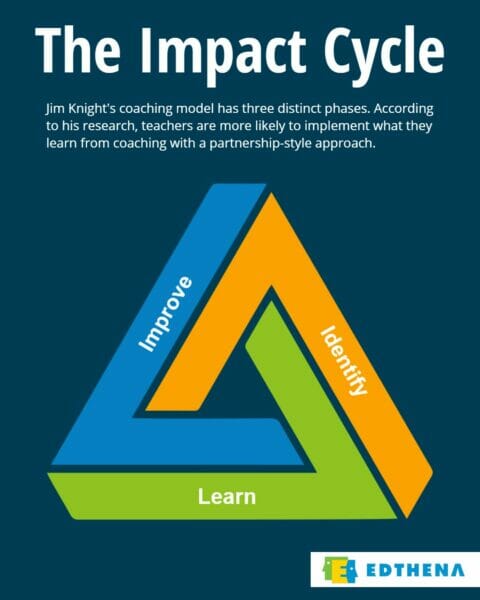Curious about the Jim Knight Coaching Model for Teachers? Let’s Break it Down
If you’re an instructional coach looking for a teacher coaching model to follow, you’ve likely heard of Jim Knight. With two decades of experience researching and studying professional learning, effective teaching, and instructional coaching, Jim Knight is a leader in coaching approaches.
So how would the instructional coaching expert describe his own teacher coaching model? What exactly is the “Jim Knight Coaching Model“?
In this PLtogether Lounge Talk, Edthena founder Adam Geller asked Jim himself and received insights into what the coaching expert considers integral to effective teacher coaching.
Also the author of The Definitive Guide to Instructional Coaching, Jim Knight shared that there are four elements in his teacher coaching model.
Described as four intersecting circles of a Venn diagram, these four Jim Knight coaching model components include:
- Beliefs
- Coaching cycle
- Coaching skills
- Strategic knowledge
For more about each component of the Jim Knight coaching model, continue reading or watch the full discussion above.
Instructional coaches are equal partners with the teachers, according to Jim Knight
For Jim Knight, instructional coaching must be centered on certain key beliefs. Citing research on what motivates people, Jim shared that these key beliefs are rooted in partnership principles.
These beliefs in practice look like instructional coaches viewing themselves as equal partners to teachers. In fact, equality is one of the 7 principles of partnership.
Jim said, “We see coaching as a conversation between two equals.”
According to his own studies, Jim found that people were four times more likely to plan to implement what they learned from a coaching conversation when their coaches used a partnership approach, rather than a directive approach.
With a directive approach, a coach determines and directs a teacher on what to do.
However, in a coaching relationship rooted in equality between two partners, teachers are in the driver’s seat of their own learning, with instructional coaches supporting and guiding them.
An effective teacher coaching model, according to Jim Knight, is built with the latter beliefs in mind, where the coaching process happens between two equals.
The Jim Knight coaching model is enacted via the ‘Impact Cycle’

The second circle of Jim Knight’s teacher coaching model is the coaching cycle: The Impact Cycle
“The Impact Cycle is the manifestation of those beliefs in action,” explained Jim.
Educators often ask, “What are the 3 steps of coaching?”
Jim Knight’s Impact Cycle has 3 parts:
- Teachers identify a goal and the strategies needed to meet that goal
- Coaches support teachers to learn how to implement that goal
- Teachers improve by making modifications in their practice until the goal is reached
Throughout all of these parts, the teacher is making the decisions about their goal-setting and implementation, not the coach.
For a deep dive into this coaching cycle, check out our blog post: Jim Knight on the Impact Cycle and PEERS Goals
Effective instructional coaches have communication skills and strategic knowledge
Listening and questioning effectively are two coaching skills that Jim Knight emphasized coaches must have in order to support and communicate with teachers.
These may seem like common skills for most coaches or managers in other fields, but the fourth component – strategic knowledge – is what sets instructional coaching apart.
Jim said, “The coach has deep knowledge of effective teaching practices, which they can share to help the teacher meet their goal.”
This expertise, or strategic knowledge, helps instructional coaches support teachers to improve. Coaches are not telling teachers what to do but can share effective strategies when a teacher is stuck on what they should do next to meet their goal.
Learning from the Jim Knight teacher coaching model
Whether you’ve been following Jim Knight’s insights for some time or are a newcomer to his work, there is much to be learned from his coaching approach.
From the key beliefs that can serve as the foundation of the coach-teacher relationship, to the necessary skills and knowledge an instructional coach should have, teacher coaches can consider how they approach their work supporting teachers using Jim Knight’s teacher coaching model.


